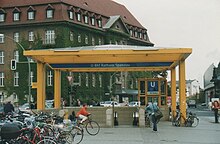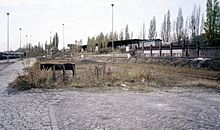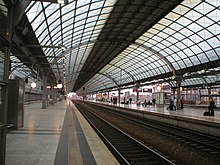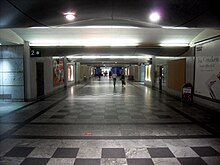Berlin-Spandau train station
| Berlin-Spandau | |
|---|---|
| Data | |
| Location in the network | Separation station |
| Design | Through station |
| Platform tracks | 4 (long-distance train) 2 (S-Bahn) |
| abbreviation | BSPD (long-distance train) BSPA (S-Bahn) |
| IBNR | 8010404 |
| Price range | 2 |
| opening | July 15, 1910 |
| Profile on Bahnhof.de | Berlin-Spandau |
| Architectural data | |
| architect | Gerkan, Marg and Partner |
| location | |
| City / municipality | Berlin |
| Place / district | Spandau |
| country | Berlin |
| Country | Germany |
| Coordinates | 52 ° 32 '5 " N , 13 ° 11' 45" E |
| Railway lines | |
|
|
| Railway stations in Berlin | |
The Berlin-Spandau station is a station of the Deutsche Bahn in Berlin district of Spandau on the southwestern edge of the old town of Spandau . The separation station is one of the more than 80 stations in the second-highest price class 2 of DB Station & Service and has the longest platform hall (440 meters) in Germany.
The station, which is used by around 45,000 travelers per day, has six platform tracks and is a transfer point between long- distance passenger transport ( ICE , IC / EC ) and local transport ( S and regional trains and regional express ). It provides connection to inner city traffic with buses or - via the underground station Rathaus Spandau the BVG - to U7 .
The current coming from the west and north-west train ( Hanover-Berlin high-speed railway / Lehrter web and Hamburger path ) is on the east of the station location Havel bridge and the ring rail or - initially parallel to Spandau Vorortbahn - the Hamburger rail terminal and the Berliner rail in the direction Berlin Central Station .
Until the planned continuation to the Havelland district, Spandau station is the provisional end point of the S-Bahn . Apart from the fact that most of the buses do not stop in front of any of the station entrances, but rather at the Altstädter Ring , the Spandau station and Rathaus Spandau bus stops are in front of the station entrance with more than ten regional bus lines and - in some cases with frequent service - urban bus lines next to the Hardenbergplatz the strongest bus node in Berlin.
description
The station has six platform tracks, four for regional and long-distance traffic and two for the S-Bahn. Outside the four-aisled hall there is also a freight track. It is listed under the abbreviation BSPD in the Deutsche Bahn operating point directory, the S-Bahn part under BSPA .
Between 1996 and 1998, the station was built while the railroad was in operation according to plans by the architects Gerkan, Marg and Partner (gmp) , who are well known for transportation structures . His design ties in with the classic railroad architecture with the distinctive barrel roofs made of glass, which are 432 meters long and completely cover the platforms. A simple platform tunnel, parallel to the new street breakthrough at Am Bahnhof Spandau , provides access to the platforms next to the reception hall under the tracks on Klosterstraße.
The lobby is 16 meters wide.
history
Lehrter station
As early as 1871 there was a station of the newly opened Berlin-Lehrter Railway at this point , which was called Lehrter Bahnhof to distinguish it from the Hamburger Bahn station in Spandau . On October 1, 1890, this station was closed again to passenger traffic. The suburban and long-distance trains stopped in Spandau only at the Hamburger Bahnhof , which was therefore called Spandau Passenger Station . The Lehrter Bahnhof took over the freight traffic of the city of Spandau and remained as Spandau Güterbahnhof , the Spandau Arcaden shopping center is located on this site. The half-timbered building of the former reception building of the Lehrter train station was dismantled in 1890 and rebuilt in 1891 as the “Stadtpark” restaurant in the Hakenfelde district .
Spandau West train station
This station was first opened on July 15, 1910 as the Spandau suburban station next to the freight station. In the same year it was renamed Spandau West , when the Spandau passenger station (Hamburger Bahnhof) was renamed Spandau Hauptbahnhof at about the same time .
The new suburban train station was cheaper than the main train station , as it was closer to the old town of Spandau and the new town hall, which was then under construction. The platforms on the embankment received the reception halls at their ends below the tracks, once across from Galenstrasse , and also at the junction of Staakener Strasse and Seegefelder Strasse , where there was also a transition tunnel to the small station of the Osthavelländische Eisenbahn .
As a three-track system with two platforms, in which the middle track was on both sides of the central platforms , the station took the Spandau suburban railway, which ended here, from the direction of the light rail . The passenger tracks of the Hamburg-Lehrter Bahn from the direction of the Lehrter Stadtbahnhof led long-distance traffic past the platforms on the north and south sides.
The suburban trains from Lehrter Bahnhof and further to Nauen or Wustermark also used the Spandau suburban tracks via switch connections to and from the passenger train iron. To the west of the station, there was the separation of the passenger tracks for joint suburban and long-distance traffic in the Hamburger and Lehrter Bahn . The suburban tracks themselves ended in a four-track storage facility for trains returning to Spandau.
Due to the commuters between Berlin, Spandau and the East Havelland towns, there was a busy traffic at the Spandau train station compared to the current regional traffic. When the Spandauer Vorortbahn received power rails for the electrification of the Berlin city, ring and suburban railways (from 1930 referred to as "S-Bahn" for short), joint operation with the steam trains from the Lehrter station continued. In the 1930s, the suburban steam trains from Lehrter Bahnhof reached Spandau West station , like the electric trains from the Stadtbahn that ended here, every 10 minutes and then continued alternately to Nauen and Wustermark every 20 minutes.
Contemporary witnesses enthusiastically report the brisk transfer traffic between the S-Bahn and the suburban railways, because back then it was possible to use the same platform quickly and easily. In today's Berlin-Spandau train station , the cumbersome platform change between the S-Bahn and regional traffic is an obstacle, which, in addition to increasing commuter traffic and insufficient access to the outskirts, once again urges the S-Bahn to be extended beyond Spandau.
For the first time on August 23, 1928, the S-Bahn to Spandau was called “Spandau West, stay back!”. Even though leading via the Lehrter Stadtbahnhof, the electric ones did not use the same route as the long-distance trains, but went west via the Stadtbahn and Spandau suburban railway . Spandau West was only supposed to remain the terminus for a few years, an extension to Wustermark or Falkensee and Nauen was always planned.
The expansion measures planned in the 1930s and 1940s were only implemented to a minor extent. From 1951 the first S-Bahn trains ran via Spandau West to Falkensee or along the Lehrter Bahn to Staaken . In the opposite direction, the S-Bahn could also get to Jungfernheide and the Ringbahn . At the same time, the Lehrter Bahnhof in Berlin was closed in 1951. The Deutsche Reichsbahn finally pulled the steam trains in the surrounding area back to the S-Bahn terminus, in Spandau West only S-Bahn stopped.
The construction of the wall on August 13, 1961 indirectly affected the station. The S-Bahn trains to Falkensee already ended in Spandau West. S-Bahn traffic to Staaken was interrupted for a few months. The line and thus also the station were more severely affected by the later Berlin S-Bahn boycott . Systems that were no longer required were exposed to the ravages of time, renovation measures were carried out less frequently, and traffic on the routes was increasingly thinned out. The S-Bahn reached its lowest point with the Reichsbahn strike on September 17, 1980. The Deutsche Reichsbahn did not respond to the demands of the railroad workers and put almost all S-Bahn traffic in the western part of the city down. September 25, 1980 marked the end of the Spandau routes and thus the Spandau West train station. Only freight trains and passenger trains from and to Hamburg drove past the orphaned station on the long-distance tracks.
Berlin-Spandau train station
The takeover of the S-Bahn by the BVG on January 9, 1984 should bring the line back into operation via a new S-Bahn station Rathaus Spandau (instead of Spandau West ) to Staaken. When the U7 underground line to Rathaus Spandau (located directly at Spandau West train station ) went into operation on October 1, 1984 , the S-Bahn plans were postponed indefinitely.
In the same decade, the first plans for the ICE connection Hanover - Berlin were made, initially intended as a transit route. Negotiations with the GDR began in autumn 1988. The fall of the Berlin Wall and, finally, the loss of the negotiating partner, with whom an agreement on the route could be reached in June 1990 , gave impetus to further planning.
The relocation of the long-distance train station from across the Havel ( old Spandau main train station ) directly to the old town and to the town hall, which had already been considered when the Spandau railway systems were converted around 1910, should now be implemented - where the worn-out systems had to be replaced anyway. In addition, the operating concept for the S-Bahn provided for the resumption of traffic via the Spandau suburban railway with the option of extending it to the surrounding area.
In 1993, the design by Spanish architect Santiago Calatrava emerged as the winner from the limited urban planning competition for the new long-distance and suburban train station . Calatrava envisaged the superstructure of the platforms with office buildings - similar to what was later on at the new Berlin Central Station. This construction plan led to financing difficulties and lengthy discussions. Finally, the third-placed design by the German architecture firm Gerkan, Marg und Partner was chosen, which was created between 1996 and 1998 after the original roof design , which was originally open on both sides, was revised. Objections of the passenger associations to the plan approval achieved a better design of the access systems to the S-Bahn platform. On May 19, 1997, the first platform of the new Berlin-Spandau station was opened to traffic, initially only long-distance and regional trains stopped . The S-Bahn drove into the completed station hall on December 30, 1998.
For the commissioning of the reorganized Berlin railway junction on May 28, 2006, the number of daily regional train stops was reduced from 250 to 212, the number of long-distance train stops increased from 66 to 100.
Critics criticize the inadequate layout of the station. The station is considered an "overloaded railroad". Between 5 a.m. and 8 p.m., passenger trains may stop at the platform for a maximum of six minutes. Turns are only permitted if the planned stop at the platform does not last longer than six minutes or if the capacity consumption is lower than for parking trips.
Subway station

The Rathaus Spandau underground station is the western terminus of the U7 line of the Berlin underground . It was opened on October 1, 1984 after it had been built using the top-down method in order to disrupt surface traffic as little as possible. With its two central platforms , the station, designed by Rainer G. Rümmler , has almost monumental dimensions. At its southern end, the platforms are spanned by a gallery through which passengers can reach the surface and from which the entire station can be overlooked. The underground station also includes the signal box for the route to Paulsternstraße . In March 2017 it was announced that the underground station - along with six others on the northern U7 line - would be listed as a historical monument .
The U7 underground line stops at the large-profile central tracks, the small-profile troughs on the outer tracks are currently empty and are intended to accommodate a planned extension of the U2 underground line, which currently only extends to the Ruhleben underground station leads. Unique for the Berlin U-Bahn, this line will stop at the platforms in left-hand traffic in order to improve the transfer connections for the planned extensions of the U7 to Staaken and the U2 to Falkenhagener Feld . An implementation of these extensions is not yet in sight.
Although the station is in the immediate vicinity of the Spandau S-Bahn station, it kept its name. So it happens that bus lines of the BVG are always identified with the designation S + U Rathaus Spandau , the S-Bahn station, however, only with S Spandau .
Transport links

The station is served by several ICE , IC and regional lines of the Deutsche Bahn , as well as the lines S3 and S9 of the Berlin S-Bahn. The U7 and numerous bus lines (including M32, M37 and M45) operated by BVG and regional bus companies from the Brandenburg area also stop at the nearby Rathaus Spandau underground station .
In spring 2006 the plans for an extension of a single-track S-Bahn route to Falkensee were finally decided. The start of construction, however, depends on the financing options. After SPD and CDU to the House of Representatives elections in 2011 a grand coalition have decided are after the coalition agreement , the plans to extend the tram route will be driven "from the station Spandau to the west to Falkensee".
Since December 2015, all ICE trains passing through the station - including three trains going through daily to Hamburg until then - have stopped at Spandau station.
Regional and high-speed rail transport
Long-distance transport
Web links
- Entry in the Berlin State Monument List (underground station)
- Berlin-Spandau train station. In: Structurae
- Track systems, permitted speeds and signals of the station on the OpenRailwayMap
- BVG map of the station (PDF; 261 kB)
- Spandau S-Bahn station at stadtschnellbahn-berlin.de
Individual evidence
- ↑ Station price list 2020. In: Deutsche Bahn. Deutsche Bahn, January 1, 2020, accessed on July 11, 2020 .
- ↑ Cleaning device tested for Spandau station roof. (No longer available online.) In: deutschebahn.com. Deutsche Bahn, August 29, 2017, archived from the original on August 30, 2017 ; accessed on August 30, 2017 . Info: The archive link was inserted automatically and has not yet been checked. Please check the original and archive link according to the instructions and then remove this notice.
- ↑ a b Association of German Architects u. a. (Ed.): Renaissance of the railway stations. The city in the 21st century . Vieweg Verlag , 1996, ISBN 3-528-08139-2 , pp. 140-146.
- ↑ Without a source
- ^ Deutsche Bahn (Ed.): Bahnstadt Berlin: Expansion of the infrastructure from 1990 to 2015 . Berlin, 2006, p. 83.
- ^ Sven Andersen: Berlin - unused capacities for decades . In: Eisenbahn-Revue International , issue 10/2005, pp. 492–494.
- ↑ Deutsche Bahn AG (Ed.): Usage specifications for the railway station Berlin-Spandau declared as congested . Annex 4.3.E to the rail network conditions of use of DB Netz AG SNB 2019, valid from December 9, 2018.
- ↑ U7 stations under monument protection . In: berliner-zeitung.de . March 28, 2017 ( berliner-zeitung.de ).
- ^ Coalition agreement 2011–2016
- ↑ Lorenz Vossen: Deutsche Bahn lets all ICE trains stop in Spandau . In: Berliner Morgenpost . No. 267 , October 1, 2015, ZDB -ID 749437-3 , p. 14 ( online ).







